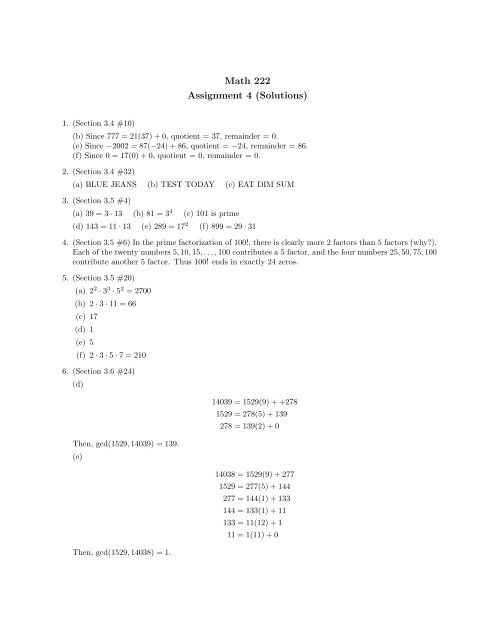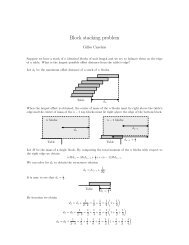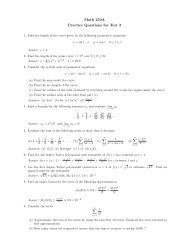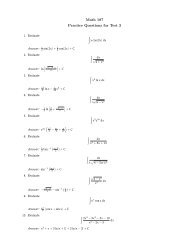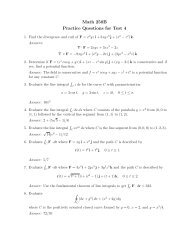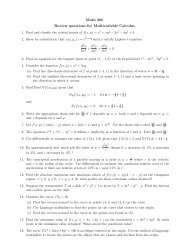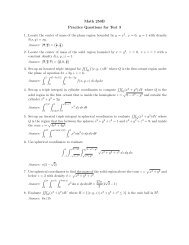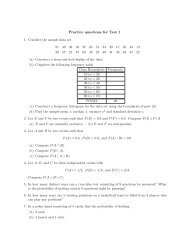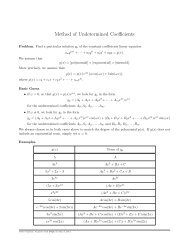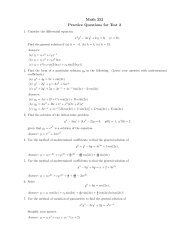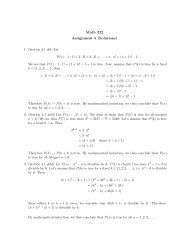Math 222 Assignment 4 (Solutions)
Math 222 Assignment 4 (Solutions)
Math 222 Assignment 4 (Solutions)
- No tags were found...
You also want an ePaper? Increase the reach of your titles
YUMPU automatically turns print PDFs into web optimized ePapers that Google loves.
<strong>Math</strong> <strong>222</strong><strong>Assignment</strong> 4 (<strong>Solutions</strong>)1. (Section 3.4 #10)(b) Since 777 = 21(37) + 0, quotient = 37, remainder = 0.(e) Since −2002 = 87(−24) + 86, quotient = −24, remainder = 86.(f) Since 0 = 17(0) + 0, quotient = 0, remainder = 0.2. (Section 3.4 #32)(a) BLUE JEANS (b) TEST TODAY (c) EAT DIM SUM3. (Section 3.5 #4)(a) 39 = 3 · 13 (b) 81 = 3 4 (c) 101 is prime(d) 143 = 11 · 13 (e) 289 = 17 2 (f) 899 = 29 · 314. (Section 3.5 #6) In the prime factorization of 100!, there is clearly more 2 factors than 5 factors (why?).Each of the twenty numbers 5, 10, 15, . . . , 100 contributes a 5 factor, and the four numbers 25, 50, 75, 100contribute another 5 factor. Thus 100! ends in exactly 24 zeros.5. (Section 3.5 #20)(a) 2 2 · 3 3 · 5 2 = 2700(b) 2 · 3 · 11 = 66(c) 17(d) 1(e) 5(f) 2 · 3 · 5 · 7 = 2106. (Section 3.6 #24)(d)Then, gcd(1529, 14039) = 139.(e)Then, gcd(1529, 14038) = 1.14039 = 1529(9) + +2781529 = 278(5) + 139278 = 139(2) + 014038 = 1529(9) + 2771529 = 277(5) + 144277 = 144(1) + 133144 = 133(1) + 11133 = 11(12) + 111 = 1(11) + 0
<strong>Math</strong> <strong>222</strong> <strong>Assignment</strong> 4 (<strong>Solutions</strong>) Page 2 of 37. (Section 3.7 #2)(d) gcd(21, 55) = 1 and 21(21) + 55(−8) = 1.(e) gcd(101, 203) = 1 and 101(−2) + 203(1) = 1.8. (Section 3.7 #8) We need to find an integer x such that 144x ≡ 1 (mod 233). Using Euclid’s algorithmto find gcd(233, 144) we get233 = 144(1) + 89144 = 89(1) + 5589 = 55(1) + 3455 = 34(1) + 2134 = 21(1) + 1321 = 13(1) + 813 = 8(1) + 58 = 5(1) + 35 = 3(1) + 23 = 2(1) + 12 = 1(2) + 0We see that gcd(233, 144) = 1. We can now use back substitution to get1 = 3 − 2 = 3 − (5 − 3) = 2(3) − 5= 2(8 − 5) − 5 = 2(8) − 5(3)= 2(8) − (13 − 8)(3) = 5(8) − 3(13)= 5(21 − 13) − 3(13) = 5(21) − 8(13)= 5(21) − 8(34 − 21) = 13(21) − 8(34)= 13(55 − 34) − 8(34) = 13(55) − 21(34)= 13(55) − 21(89 − 55) = 34(55) − 21(89)= 34(144 − 89) − 21(89) = 34(144) − 55(89)= 34(144) − 55(233 − 144) = 89(144) − 55(233)Since 144x ≡ 1 (mod 233) is equivalent to 144x − 1 = 233k for some integer k, we see that a possiblevalue of x is x = 89 since we have144(89) − 1 = 233(55).Therefore 89 is an inverse of 144 modulo 233.9. (Section 3.7 #12) We need to solve 2x ≡ 7 (mod 17). Since 2 · 9 ≡ 1 (mod 17), multiplying both sidesby 7 gives, 2 · 63 ≡ 7 (mod 17). We then get x = 63, modulo 17. Since 63 mod 17 = 12, all solutions arethen x = 12 + 17k, for all k ∈ Z.10. (Section 3.7 #18) We need to solve the following.x ≡ 2 (mod 3)x ≡ 1 (mod 4)x ≡ 3 (mod 5)
<strong>Math</strong> <strong>222</strong> <strong>Assignment</strong> 4 (<strong>Solutions</strong>) Page 3 of 3Since the integers 3, 4, 5 are pairwise relatively prime, the Chinese Remainder Theorem implies thatthere is a unique solution modulo M = 3 · 4 · 5 = 60. Let M 1 = M/3 = 20, M 2 = M/4 = 15, andM 3 = M/5 = 12. Consider the three equationsM 1 y 1 = 20y 1 ≡ 1 (mod 3)M 2 y 2 = 15y 2 ≡ 1 (mod 4)M 4 y 4 = 12y 4 ≡ 1 (mod 5)Using Euclid’s algorithm (or by inspection) we get the solutions y 1 = 2, y 2 = 3, y 3 = 3. From theChinese Remainder Theorem with a 1 = 2, a 2 = 1, a 3 = 3, we getx ≡3∑M k y k a k ≡ 20(2)(2) + 15(3)(1) + 12(3)(3) ≡ 233 (mod 60).k=1The smallest positive value of x is then x = 233 mod 60 = 53.All solutions are then x = 53 + 60k, for k = 0, ±1, ±2, . . . .11. (Section 3.7 #46) Translating the letters of “ATTACK” into numbers we get: 0019 1900 0210. We need tocompute E(M) = M 13 mod 2537 for M 1 = 19, M 2 = 1900, and M 3 = 210. We get (E(M 1 ), E(M 2 ), E(M 3 )) =(2299, 1317, 2117). The encrypted message is then 2299 1317 2117.


